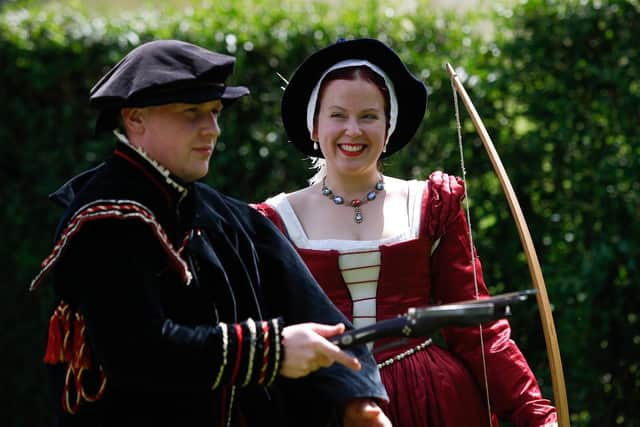Time to re-open Scotland's coldest murder case? Did the Earl of Bothwell really kill Mary Queen of Scots' husband Lord Darnley? – Susan Morrison
In May 1567, James Hepburn, Earl of Bothwell, intercepted Mary Queen of Scots on the Stirling road. He said her life was in danger. He insisted she return with him to his castle in Dunbar. To help her make her mind up, he had around 800 armed men at his back.
Mary did go with him, but what happened next is less clear. Did Bothwell rape the queen, or did she succumb willingly? Either way, he got her to the altar to marry him. It was his chance to be a new King James of Scotland. It was the second biggest mistake of his life. His biggest mistake was waiting patiently in Denmark for payback.
Advertisement
Hide AdAdvertisement
Hide AdBad boy Jimmy Hepburn gets a bad press, and with some justification. Even against the background of a Scottish court rammed with booze-fuelled armed young men with anger management issues, Bothwell made a name for himself as someone to avoid if he was in a mood.
On the upside, he was a handy fella to have around if you needed a man of action. Despite his Protestant faith, he was loyal to Catholic Mary of Guise during her Regency of Scotland. He jumped a column of men bringing 6,000 English crowns to fund rebels against her, and handed it over to a very grateful regent. He was the First Lord of the Admiralty, and seemed to know what he was doing on a ship. He was highly regarded in France as a gentleman. When Mary, Queen of Scots returned to Edinburgh she kept James busy dealing with rebellions, revolts and chase-about raids. He also spent just about the same amount of time feuding with everyone at court.
He married the formidable Lady Jean Gordon in 1566. Her family had fluctuating fortunes. Her own father had been tried for treason. He was dead before the trial started. Not a problem for Scottish law. They just propped his embalmed corpse up in the dock. The marriage was short-lived. A year later, she divorced Bothwell. Possibly she'd been persuaded to divorce so that James could marry someone else. The queen herself.
Mary was now widowed by the most unfortunate death of her husband, Lord Darnley, blown up and strangled by person or persons unknown. Most people looked at Bothwell and said, “yep, he done it”. To be fair, no one much liked Darnley, not even Mary. Still, blowing people up is generally frowned upon, and Mary’s decision to marry the chief suspect triggered the sort of scorching letter from Elizabeth I that makes people in customer services quail.
Mary married him. Scotland exploded. Bothwell fled. He may have had a notion of heading to Europe to raise funds and an army to regain Mary’s abdicated throne. A storm drove his ship into Norwegian/Danish waters. He was arrested and taken to Bergen. And that’s where Anna Throndsen was waiting, a woman with some seriously powerful connections. Not good news for James, because she was his first, abandoned wife.


James and Anna had met back in 1559. She fell for his dubious charms, and went through a form of marriage with him. She certainly brought some serious money with her, which James burned through in next to no time and then dumped her. His biggest mistake.
And now here he was. King Frederick II of Denmark seems to have regarded Bothwell as a useful bargaining tool at first. But then by 1573, his value was wiped out. Mary clearly wasn’t returning for her crown, and the lads in Edinburgh didn’t seem that keen on getting him back.
Pity. Still, His Majesty could have used a man handy with a blade and no money. He had a few wars on the go. There were Scottish fighting men in many European armies. But he didn’t. After all, there was Anna and her honour to consider.
Advertisement
Hide AdAdvertisement
Hide AdJames Hepburn, fourth Earl of Bothwell, First Lord of the Admiralty, was thrown into a dungeon at Dragsholm Castle, chained to a pillar and left to rot. He wore a groove in the floor as he walked around it endlessly for the last five years of his life. He went mad.
In 1578, they found him dead. He was 44. They buried him in a little local church. In 1858, they were astonished when they opened the casket and found an eerily well-preserved James staring back at them. They put him on display, but re-buried him a few years ago.
Now, there’s no doubt that James deserved much of his villainous reputation, but he lived in violent times. Yes, he was ambitious, but he wasn’t the only one who tried for the throne through marrying the queen. The Earl of Arran also wooed Mary. He also went mad.
Yes, Bothwell treated Anna appallingly. He wasn’t much kinder to Lady Jean Gordon. Had his marriage to Mary lasted, he probably wouldn’t have been much good for her either, although she might have welcomed a strongman enforcer beside her. And yes, he was quick-tempered and picked fights with everyone, but when Rizzio was carved up in front of Mary, James stayed cool and remained loyal.
Finally, had he really murdered Lord Darnley, Bothwell would have known it needed to ‘look like an accident’. A knife between the ribs in some rough tavern. A tragic fall from a horse whilst hunting under the influence.
That explosion was a tad too theatrical. Other people gained massively from Bothwell’s disgrace and Mary’s abdication The very people not too keen on getting that chief suspect back. It’s almost like they didn’t want the case reopened. Perhaps it's time we brought him back and took a closer look at the notorious Earl of Bothwell and his life.
